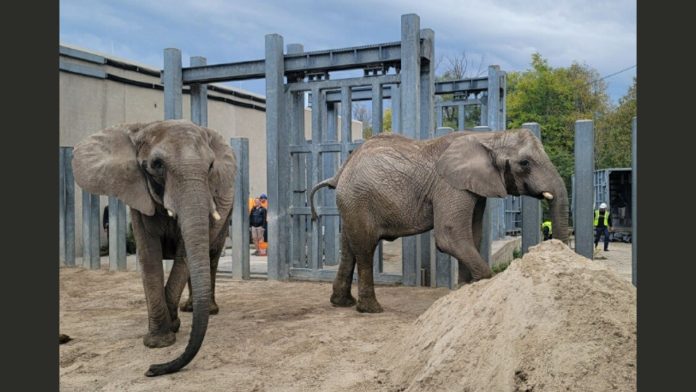
SALT LAKE CITY, Utah, Oct. 19, 2023 (Gephardt Daily) — Former Hogle Zoo residents Christie and Zuri have joined a new herd of African elephants in Kansas City, Missouri.
Utah’s Hogle Zoo officials Thursday announced the elephants’ arrival at the Kansas City Zoo and Aquarium, where they’re joining a multigenerational herd of seven other African elephants.
The herd includes females Lady, who at 55 is the oldest African elephant in the U.S.; Lois, Lea, Megan and Tattoo, all 45; and Zoe, 39. It also includes a male bull, Tamani, 18, who is a genetically diverse match for Zuri, 14, zoo officials said.
Christie, 37, gave birth to Zuri, 14, at Utah’s Hogle Zoo in 2009.
The zoo announced Christie and Zuri’s planned departure in May, with the goal of providing them both the best chance to have a calf.
Kansas City Zoo was selected by Utah’s Hogle Zoo staff and other experts in the Association of Zoos and Aquariums Species Survival Plan for African elephants. The survival plan identifies genetic and breeding pairings for vulnerable and endangered species in AZA accredited zoos, officials said.
The joint herd will live together on more than 3 acres of outdoor space, including a large pool, mud hole, two waterfalls, shade structures and a variety of substrates for the elephants to explore, interact and train, according to the news release.
KCZoo completed $10 million in upgrades to its Elephant Expedition in 2020 and recently renovated an indoor space for Tamani.
Zookeeper and vet staff from both zoos traveled with the elephant pair, and two of Utah’s Hogle Zoo elephant keepers will stay at KCZoo for three to six months to help with the transition, zoo officials said.
Christie and Zuri will be in a publicly visible quarantine yard before they start to meet the rest of the herd, according to the news release. Upon the newcomers’ arrival, however, the current herd and new elephants will be able to see, hear and smell each other, zoo officials said.
Physical introductions to the current herd will begin as soon as deemed appropriate by the veterinary health and animal care teams, according to the news release.
The world’s African elephant population declined from 1.1 million in the 1970s to approximately 450,000 today, with an estimated 100 elephants killed every day, according to Utah’s Hogle Zoo.
With the support of the community, the Utah zoo will continue to fund worldwide elephant conservation projects to secure important habitats, build ranger stations in East Africa and form anti-poaching scouting teams.






